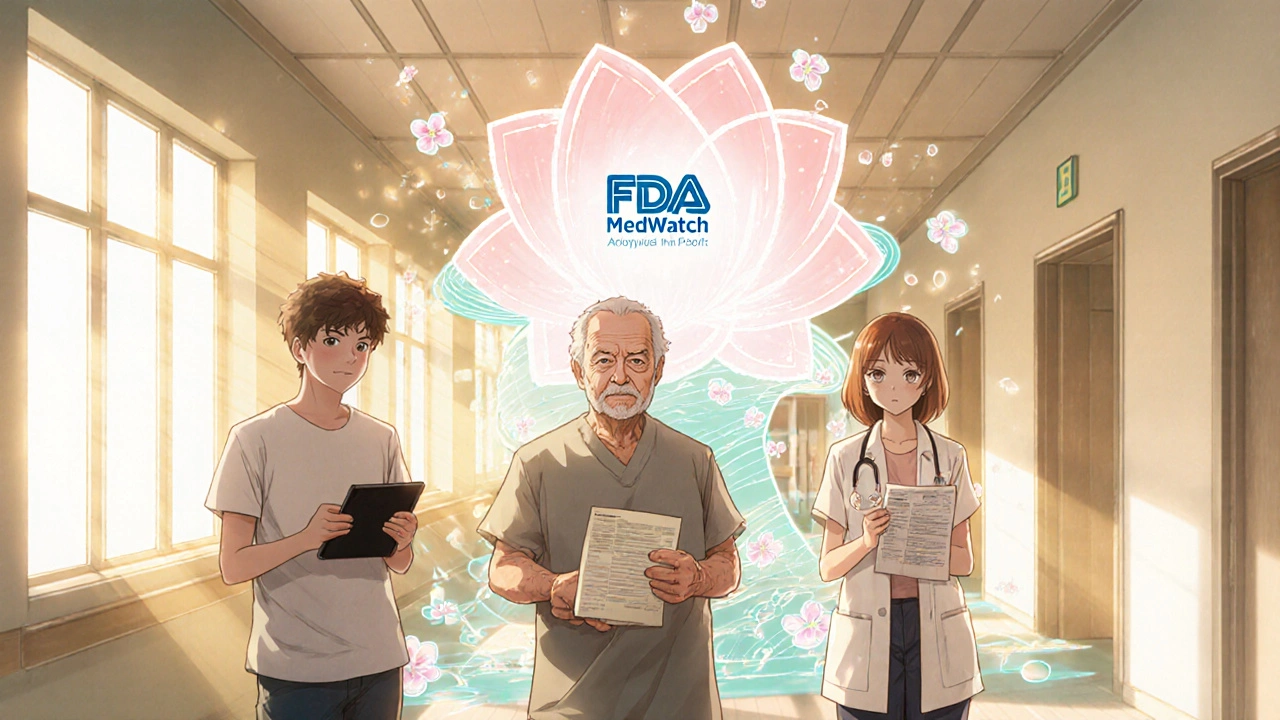Every year, millions of people take prescription drugs, over-the-counter medicines, and dietary supplements without issue. But for some, a medication can cause a serious reaction - one that wasn’t listed on the label, wasn’t caught in clinical trials, and might not show up until thousands of others have taken it. That’s where MedWatch comes in. It’s not a hotline you call when something goes wrong. It’s the system that turns your report into a safety alert that could save someone else’s life.
What Is MedWatch and Why Does It Matter?
MedWatch is the U.S. Food and Drug Administration’s official program for collecting reports about serious side effects, product defects, and treatment failures involving FDA-regulated products. That includes prescription and over-the-counter drugs, vaccines, medical devices, biologics like blood transfusions and gene therapies, and even some cosmetics and infant formulas. It’s not a fancy app or a government dashboard. It’s a quiet but powerful early-warning system. When a drug is approved, it’s tested on a few thousand people. But once it’s out in the real world - used by millions - rare side effects can show up. That’s when MedWatch kicks in. A single report from a patient or doctor might be the first clue that a medication is causing heart problems, liver damage, or dangerous interactions. In 2021, MedWatch received over 1.4 million reports. About 65% were about drugs and biologics. Of those, hundreds led to label changes, safety warnings, or even product withdrawals. One well-known example: reports of increased heart attack risk with the diabetes drug rosiglitazone came in through MedWatch, leading to major restrictions in 2010.Who Can Report and How?
Anyone can report to MedWatch - patients, caregivers, doctors, nurses, pharmacists, and even manufacturers. But the process is different depending on who you are. Healthcare professionals use Form FDA 3500. It’s detailed. You’ll need to include the patient’s age, sex, medical history, the exact drug name and dose, when the reaction happened, what symptoms showed up, and whether the patient was hospitalized or had a life-threatening reaction. This form is meant for serious events: death, hospitalization, permanent disability, birth defects, or anything that required urgent medical care. Patients and consumers use the simpler Form FDA 3500B. It’s designed to be easy. You don’t need medical training. You just answer: What medicine did you take? What happened? When? Did you go to the doctor? The form is available in Spanish, too, since 2022. Manufacturers have to report. If they find out a product caused a serious problem, they’re legally required to notify the FDA within 15 days. That’s mandatory. Consumers aren’t. And that’s where the system has a big gap.How to Submit a Report
There are three ways to file a report:- Online - Go to fda.gov/MedWatch. The portal walks you through step-by-step. It takes about 15-20 minutes. You can save and come back later if you don’t have all the info.
- By phone - Call 1-800-FDA-1088. A live agent will take your report over the phone. Average wait time is under 3 minutes.
- By mail or fax - Download the PDF form from the website, fill it out, and send it. The FDA still accepts paper forms.
What Counts as a Reportable Event?
You don’t have to guess whether your experience is serious enough. The FDA gives clear guidelines:- Death
- Hospitalization (or prolonging a hospital stay)
- Permanent disability
- Life-threatening reaction
- Birth defect or miscarriage
- Any event that required medical or surgical intervention to prevent one of the above

What Happens After You Report?
The FDA doesn’t call you back. There’s no case number. No tracking. That’s the biggest complaint from users. On Reddit and patient forums, people say they reported a reaction, waited months, and never heard a word. That’s normal. MedWatch isn’t designed to give you updates. It’s designed to find patterns. Your report gets added to a database with over 1.4 million others. Analysts look for clusters: “Are 50 people reporting liver damage after taking Brand X?” If the signal is strong enough, the FDA may issue a safety alert, update the drug label, or even pull the product. In 2021 alone, MedWatch data helped trigger 18 label changes and 3 product withdrawals. The system isn’t perfect. Studies show only 1-10% of serious side effects are ever reported. Most patients don’t know MedWatch exists. A 2022 survey found 78% of Americans had never heard of it. But when people do report, they’re often right. One study found that 85% of those who used MedWatch found the form easy to complete - once they found it.Why Reporting Matters - Even If You Think It’s Minor
You might think: “My rash went away. It’s not a big deal.” But here’s the thing: drugs aren’t tested on people with diabetes, kidney disease, or those taking five other medications. Your case might be the first sign that a drug is dangerous for a specific group. A 2023 study in JAMA Network Open showed oncologists and psychiatrists report side effects far more often than primary care doctors. Why? Because they see patients with complex conditions. But a simple cold medicine might cause dangerous interactions in someone with high blood pressure. If no one reports it, that risk stays hidden. MedWatch isn’t just for drugs. A faulty glucose monitor that gives false readings? Report it. A dietary supplement that causes seizures? Report it. A baby formula that leads to severe diarrhea in multiple infants? Report it. The system covers it all.Limitations and What’s Changing
MedWatch has weaknesses. The biggest? It’s passive. It waits for you to speak up. Meanwhile, the FDA is building something better: the Sentinel Initiative. That system actively scans electronic health records from 300 million patients. It doesn’t wait for reports - it finds problems on its own. But Sentinel doesn’t replace MedWatch. It complements it. MedWatch gives the human voice - the patient’s story. Sentinel gives the big data. Together, they’re more powerful. The FDA is also testing AI to sort reports faster. In a 2022 pilot, AI cut review time for high-priority cases by 35%. They’re also planning to let health apps and EHR systems send reports directly by 2025. That could make reporting automatic - like a built-in safety net. Still, the biggest barrier isn’t technology. It’s awareness. If you don’t know MedWatch exists, you can’t use it.What You Can Do Today
If you’ve had a bad reaction to a medication, supplement, or device:- Go to fda.gov/MedWatch - it’s free, secure, and available 24/7.
- Use the consumer form (FDA 3500B) if you’re not a professional.
- Write down what happened: date, time, symptoms, drug name, dose, and how long it lasted.
- Don’t wait for someone else to report it. Your report could be the one that starts a safety investigation.
Frequently Asked Questions
Do I need to be a doctor to report a side effect to MedWatch?
No. Anyone can report - patients, family members, caregivers, or even friends. The FDA has a simplified form (FDA 3500B) designed for consumers. You don’t need medical training. Just describe what happened, when, and what product you took.
Is MedWatch only for prescription drugs?
No. MedWatch accepts reports for prescription drugs, over-the-counter medicines, vaccines, biologics, medical devices, dietary supplements, cosmetics, and infant formulas. If it’s regulated by the FDA, it’s covered.
Will the FDA contact me after I submit a report?
Usually not. MedWatch doesn’t provide case tracking or follow-up. The system is designed to collect data, not respond to individuals. Your report becomes part of a larger database used to spot trends. If your report helps identify a new safety issue, you won’t get a call - but someone else might be saved because of it.
What if I’m not sure if the medicine caused the problem?
Report it anyway. The FDA doesn’t need proof - they need signals. If multiple people report the same symptom after using the same product, analysts can detect a pattern. Many safety issues were first noticed because someone said, “I’m not sure, but…”
Is there a cost to report to MedWatch?
No. Reporting is completely free. There are no fees, no subscriptions, and no hidden charges. You can report online, by phone, mail, or fax - all at no cost to you.
Can I report a side effect from a supplement I bought online?
Yes. Dietary supplements are covered under MedWatch. Even if the product wasn’t FDA-approved, if it’s sold in the U.S., you can report adverse reactions. Many serious reactions from unregulated supplements have been caught through MedWatch reports.
How long does it take for the FDA to act on a report?
There’s no fixed timeline. Some reports lead to quick warnings if they’re part of a cluster. Others sit in the system for months or years until enough similar reports come in. The FDA reviews reports daily, but action depends on the volume and seriousness of the pattern - not on individual reports.
Are MedWatch reports confidential?
Yes. The FDA protects your personal information. Your name, address, and contact details are kept confidential and are not made public. Only de-identified data is used for analysis. You can choose to leave your contact info if you want to be reached, but it’s optional.
Next Steps: What to Do If You’ve Had a Bad Reaction
If you’ve experienced a serious side effect:- See your doctor to confirm what happened and rule out other causes.
- Write down everything: dates, symptoms, medication names, doses, and how long it lasted.
- Go to fda.gov/MedWatch and fill out the consumer form. It’s quick. It’s free. It matters.
- Keep a copy of your report for your records.
- Tell others. Many people don’t know this system exists. Share the link.


Michael Salmon
November 19, 2025 AT 06:00Let's be real - MedWatch is a glorified suggestion box for people who think their headache is a national emergency. The FDA gets over a million reports a year, and 95% of them are ‘I felt weird after taking ibuprofen.’ Meanwhile, actual dangerous drugs slip through because no one with a brain reports the real stuff. This system is a joke wrapped in a bureaucratic bow.